Glimpses of Healing and Hope
Glimpses of Healing and Hope

May 8, 2017
By: Jane Bishop Halteman
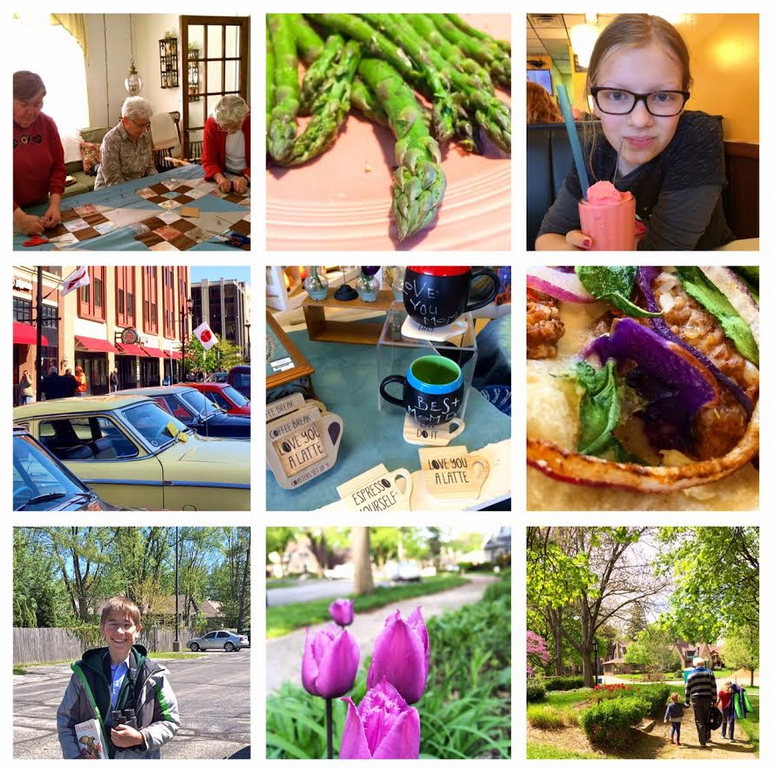
Life-giving encounters: knotting comforters, observing spring, celebrating family milestones, tracking Studebakers, volunteering at Villages, birdwatching
Parker Palmer’s What’s an Angry Quaker to Do, posted at On Being March 29, escaped me until this past week, but managing anger seems a worthy topic during the season of Eastertide, particularly this season of Eastertide when many people of faith find themselves at political odds with friends and neighbors, perhaps family, or in particular the present administration.
Palmer's column opens like this: “I’m a Quaker. I stand in a religious tradition that asks me to live by such values as community, equality, simplicity, and non-violence. As a result, I frequently find myself in deep oatmeal—especially when it comes to politics, where I seem to have an anger management problem. Not long ago, a friend with whom I’d been having a heated political argument gave me a black t-shirt that says ‘One Mean Quaker.’”
Asking if anger can find “a role to play in the life of someone who aspires to non-violence,” Palmer says his response is different in three ways from those who “regard anger as a spiritual flaw to be eliminated.”
He suggests that “whitewashing in the name of God doesn’t improve the world—it discredits religion as yet another source of delusion.” Secondly, he says, he has discovered that forgiveness “is not always mine to give.”
And finally, he states that, while he is aware anger can harm the angry one, he has learned from three serious depressions that buried anger “poses more threats to my well being—and that of those around me—than anger expressed non-violently. Repressed anger is dangerous. Anger harnessed as an energy we can ride toward new life for all concerned is redemptive.”
Palmer reports wanting to “redouble my efforts to help us renew our capacity for civic community and civil discourse. I want to ride the energy of anger toward work that brings citizens together in life-giving live encounters—knowing that if the reality of ‘We the People’ continues to fade into mist and myth, we’ll lose our democracy.”
What ways have you found to ride the energy of anger in the current political climate or some other situation where you recognize that anger might be debilitating if not directed in healthy ways? Connections are important to me; I have recently broadened my connections to take on more responsibility to offer social media services to our own Ten Thousand Villages store along with other peace and justice efforts around town.
Most weeks I find myself sufficiently “distracted” by family, church, and local activities so that pent-up anger is diffused positively by engaging in life-giving encounters. This past week, as illustrated in the collage above, I enjoyed tying a few knots with Barbara and Elaine on a comforter Betty made for refugees, paying attention to spring vegetables and flowers and the general greening up of our part of the world, celebrating a family birthday, doing some social media posts for Villages, cruising four blocks of Studebakers in downtown South Bend, and learning some new birdwatching tips from Marty.
A number of people from our congregation gather the second Monday of each month (that’s tonight at 6:30 if you are interested in joining them) “to talk about and take political action. We meet regularly at Restoration Farm and anyone is welcome to come. We update, encourage, share articles that are useful to read, attempt to take the pulse of the public and governance. We also laugh a lot, good medicine these days,” says Danile.
I hope to post more information next week on this KRMC group’s due diligence with respect to informed citizen action; in the meantime, take a moment between now and then to listen to Home of the Brave (Immigrants and Pilgrims and Refugees), shared on Facebook this week by a friend. The link features a new song by JD Martin (whom some of us knew as Jerry Derstine back in the day) and two other songwriters who, it appears, have found a useful way to manage post-election energy.
Add a commentMay 1, 2017
By: Jane Bishop Halteman

How a Saint Mary's College reflection photo created connection...
“People say, what is the sense of our small effort? They cannot see that we must lay one brick at a time, take one step at a time. A pebble cast into a pond causes ripples that spread in all directions. Each one of our thoughts, words, and deeds is like that. No one has a right to sit down and feel hopeless. There is too much work to do.”
Finding this quote from Dorothy Day, Catholic social activist and co-founder of the Catholic Worker movement, reminded me this past week that it’s too soon to quit during what feels like a tumultuous time in our country and our world.
Making connections in this season of resurrection is one way to revitalize flagging hope. I made an interesting connection a few days ago via a photo challenge in which I participated during the month of April. Hosted by Susannah Conway, who provides on-line photo prompts (suggestions to help participants find photo opportunities), this contemplative daily discipline reminds members to “use the challenge as a way to give yourself ten minutes to notice your surroundings and take a breath.”
With a series of prompts like ‘serenity,’ ‘doorway,’ and ‘reflection,’ contributor photos and journal entries offered a dose every day in April of profound day-brighteners and thoughtful sentiments about the ups and downs of the journey. Two days after I posted the above photo in response to the ‘reflection’ prompt, I heard from Marian in Florida, who recognized Saint Mary’s College as the place where her friend conducts a women’s chorus: “Beautiful, Jane!” she said. “If you get the chance to hear the Saint Mary’s chorus or South Bend Chamber Singers, do go! My friend directs some beautifully ‘reflective’ concerts with both choirs.”
More on-line correspondence led to the awareness that both Marian as a musician and I as a journalist are involved in “writing” story. I was intrigued by her understanding of prepping choral presentations as “writing” them and googled her name; what a delight to discover her TEDx talk entitled Transformative Listening.
The introduction to her talk says this about her: “As a choral conductor, Marian Dolan examines silences broken by stories told through song and the level of understanding and compassion we can achieve if we listen. These musical stories give us an opportunity to better the world by listening and allowing others to heal by sharing their stories.”
The introduction further asserts that “Marian Dolan is a musician. When asked what she plays, she smiles and answers: people. She’s a choral conductor, so her ‘instrument’ is literally a very human one. Together, a chorus and director are artistic storytellers, singing stories-in-song….Breaking boundaries to sing stories means being a bridge-builder of connection and community.”
I urge you to watch Marian’s TEDx talk, where you will find her sharing about the concert she named Voices of Courage (marking 10 years since 9/11) and the concert she called Finding a Voice (honoring women who chose to say ‘no’ to gender violence as they used lament to break their silence and move from hope to healing and eventual restoration).
She offers a clip from this performance of Senzenina and the amazing story of meeting Archbishop Desmond Tutu of South Africa while she was in her second year as a music professor in the theology school at Emory University.
She recalls Tutu’s answer to another faculty member’s question at a retreat where she first met the archbishop: “When the painful stories were so overwhelming, what did you do?” Referencing his experiences with Truth and Reconciliation Commission (TRC) hearings where victims of apartheid violence were invited to share their stories before the commission and perpetrators, Tutu responded: “I sang…when my spirit could hold no more, I sang.”
Marian remembers that “he quietly started singing right there” with the gathered faculty on retreat, just as he had done in those TRC hearings. Senzenina means “What have we done to deserve this?” and begs an answer to the much larger question “Why is this violence perpetrated on us?” she explains.
“I've really sat with that greater insight in light of Tutu singing it in the TRC hearings, and of his musical invitation being responded to by all who are present... that after hearing these horrifically real, long-silenced, very personal stories of violence, for him to start the communal singing Senzenina is, to me, beyond powerful. I can't even begin to imagine the sound of that communal ‘lament’ in that room in that moment...of what it meant for all who were present to literally ‘carry’ the now-unsilenced story and lament therein.”
As we continue the Eastertide journey of resurrection living, notice opportunities to engage in life-giving connections and transformative listening. Who has helped you unveil more of your own journey stories? Who have you listened into revealing more of his or hers? How are we becoming “bridge-builders of connection and community,” perhaps actually helping to carry the pain of another?
Add a comment
April 24, 2017
By: Jane Bishop Halteman
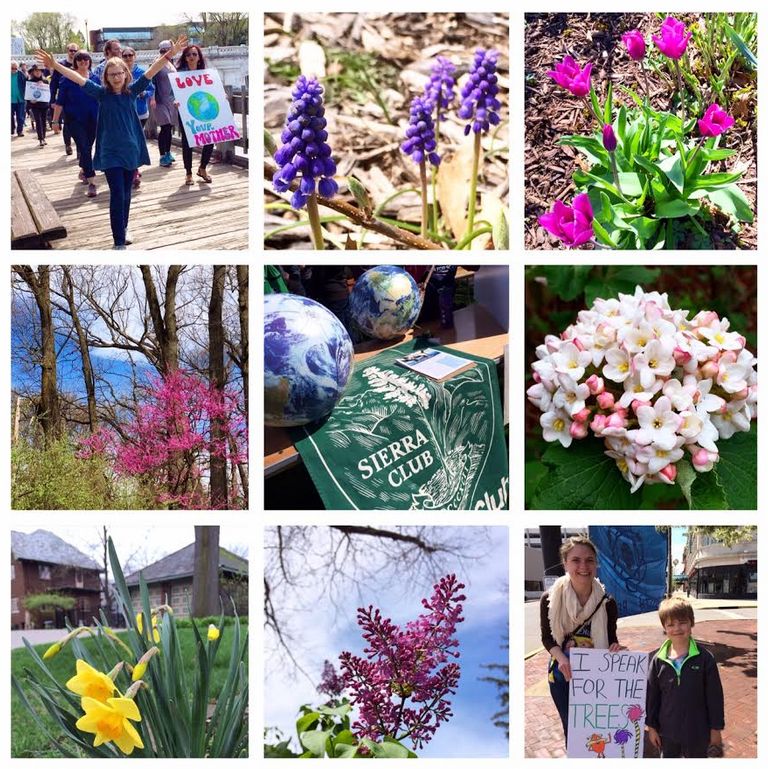
Our wonderful Earth; how do we keep it safe from harm?
Earth Day (this past Saturday) and the last few days here in South Bend couldn’t have been more beautiful…vivid blue skies and off-and-on-again warmth coaxed out bright green leaves and glorious blossoms like redbud and dogwood. Jenny Wrens sang lustily as fragrance exploded from backyard viburnum and lilac bushes.
Local planners reportedly expected 300-400 marchers in Saturday’s March for Science: South Bend, which coincided with Earth Day, and were pleasantly surprised by a turnout estimated at 1,100, according to an on-line article in the South Bend Tribune.
“The March for Science began as a notion batted around online on Reddit after the Women’s March on Washington, which was held January 21, the day after the inauguration. The idea snowballed after it was endorsed by numerous mainstream science organizations, which vowed that it would not be a partisan event. It eventually became a global phenomenon, held in more than 600 cities on six continents—and cheered on by scientists on a seventh, Antarctica,” a story published Saturday by The Washington Post reveals.
Earth Day Network reports that back on the first Earth Day “on April 22, 1970, 20 million Americans took to the streets, parks, and auditoriums to demonstrate for a healthy, sustainable environment in massive coast-to-coast rallies,” noting that “in the spirit of the teach-ins brought on by the original Earth Day, we are here again to promote awareness of the urgent and unprecedented need to show up for our environment so we can live healthy and sustainable lives.”
According to its website, the Sierra Club, founded by conservationist John Muir in 1892, is “the nation’s largest and most influential grassroots environmental organization, with more than two million members and supporters. Our successes range from protecting millions of acres of wilderness to helping pass the Clean Air Act, Clean Water Act, and Endangered Species Act. More recently, we’ve made history by leading the charge to move away from the dirty fossil fuels that cause climate disruption and toward a clean energy economy.”
The Sierra Club works to “mobilize voters to pressure Congress and other policymakers to protect endangered species, defend national parks and wildlife refuges from dangerous drilling, stop the Keystone XL pipeline, prevent reckless new offshore drilling in the Arctic, Atlantic, Gulf and Pacific, and save the Environmental Protection Agency from an onslaught of attacks that threaten our health and our planet.”
A local South Bend Sierra Club chapter, which had been largely inactive in recent years, has revitalized since January in the wake of present administration activity. These articles reveal some of the broader reasons why people participated in the March for Science on Earth Day: famine and deforestation. Nature Conservancy president and CEO Mark Tercek shares here why that organization supports “science-based work managing and protecting our parks, wildlife refuges, sea shores, fisheries, forests, air and water quality.” For more Earth Day history, read last year’s Glimpses of Healing and Hope blog post here.
Brad Roth, pastor of West Zion Mennonite Church in Moundridge, KS, said in a Mennonite World Review article this past week that “Earth Day is a great time for Christians to show our love for God’s green Earth.” Suggesting that “love for the soil may be the most biblical way to approach love for the Earth,” Roth says, “God placed Adam and Eve in the garden to ‘tend and care’ (Gen. 2:15) for the adamah—‘soil’ or ‘earth’ (3:23). Humanity’s care for Eden was first and foremost care for the soil.”
He continues, “Undoubtedly, God’s charge to tend and care for the soil had to do with its fragility. Soil is a resource that only slowly renews through the action of fungi and bacteria, insects, and earthworms. But more than the soil’s fragility, it’s perhaps the soil’s capacity to bring forth new life that causes God to confer on humankind a special charge to tend and care for it.” Roth concludes that some of the best ways for people of faith to take care of the soil are planting a garden, making compost, and encouraging earthworms.
Mennonite Central Committee reports seven ways it cares for God’s creation (solar power, selling thrift, recycling, energy efficiency, geothermal promotion, and advocacy work) in this article; Mennonite Creation Care Network leader Jennifer Halteman Shrock offers insights here into how congregations might get started with creation care based on individuals’ interests and perspectives. She describes “simple living servants, foodies, gardeners, and building geeks” as householders, the doers or ‘hands and feet,’ while she names the “naturalists, wounded witnesses, and watershed disciples” as regionally rooted or ‘heart’ people. Finally she categorizes the “theologians, activists, and professionals” in the congregation as the big picture people whom she designates the ‘eyes of the body.’ The challenge for individual congregations becomes sorting out individual gifts and coming to understand how those gifts and interests might merge to facilitate Earth care.
National Public Radio’s Chew on this for Earth Day offers ways to consider how what we eat takes a toll on the Earth. The story challenges readers/listeners to waste not, want not; rethink eating beef and lamb; consider plant-based dishes in restaurants.
Spirituality & Practice offers these 12 Spiritual Practices to Honor the Earth. “Spiritual practices are the best ways we know to demonstrate kindness and courtesy toward the Earth, to express our gratitude and wonder, to yield to the mystery and the beauty of it all,” the authors say. Will you practice attention to nature, devotion to the Earth, joy in the plant and animal kingdom, openness to your environment, or perhaps recommit yourself to living “lightly and respectfully on the planet” during this season of resurrection?
Add a commentApril 17, 2017
By: Jane Bishop Halteman

Trees begin to show the green haze of spring, a resurrection reminder
Back on April 1 the Fetzer Institute offered this post which featured “Hurry,” a poem from the Afghan Women’s Writing Project, which said, in part:
I don’t have money, power
or authority, but I have God who gave me
a mouth with lips for smiling, I have language for speaking,
I can use them for good,
to carry messages of peace and love and forgiveness.
Using our smiles and language for good are commitments we might all make in the face of unrest around the world as we begin to live into the post-Easter season of resurrection, sometimes called Eastertide.
Holy Week brought us face-to-face with violence once again, as we continued to lament the loss of UN peacekeeper MJ Sharp (see his father’s Facebook page here for more information) and cringed as our own country dropped the ‘mother of all bombs’ on Afghanistan.
Iris de Leon-Hartshorn offers these words in Lament and Prayer for Afghanistan: “We as a church lament that our country operates within a paradigm that violence can produce peace. We as a nation continue to practice violence against our enemies. We confess our own complicity in how we too support such actions with the use of our tax dollars and in our daily interactions when we do not extend our hands to our enemies. We ask for God’s mercy and forgiveness.”
Pastor Dave reminded us in his Easter morning sermon that “God still brings life out of our dark and dead places” with a brief telling of the story of Patrick who pushed his friend Justin in a wheelchair across northern Spain on the 500-mile El Camino de Santiago. Dave spoke of the power of community and the fact that nearly 200 persons representing 27 nations assisted Patrick and Justin on the way, exemplifying the power of resurrection love from strangers.
This link to last year’s Glimpses of Healing and Hope Easter blog references Frederic and Mary Ann Brussat’s Easter: Resurrection as Spiritual Practice page at their Spirituality & Practice website. They offer a variety of options for living into the resurrection, including these: find ways to recognize renewal of life around you; notice radiance in people, places, growing things as signs of new birth; make way for new life by breaking down barriers; live in the moment (the only time the Divine brings forth new life); set the stage for new life by working for peace and justice; stay open to change as a sign of your receptivity to transformation.
And then there’s Anne Lamott who pretty much always speaks her mind and many of our minds as well. Perhaps this is how to achieve resurrection living in the midst of chaos of one kind or another: “It's amazing to stop pretending that things are not as bizarre and dire or hard as they are, in the marriage, for your grown child, in the nation. To be where your feet are, and to feel it all: the swirl of doom, of gratitude, of incredulous fear, of wonder, of hate, judgment, love.” For more from Anne, see the rest of her post here.
Nancy, who just returned from DR Congo last week, reported in yesterday's service that she witnessed resurrection power as she observed a literacy teacher-training program in Kinshasa. Read more about her experience here and watch her blog for future musings.
Where do you notice signs of the resurrection like peace, love, forgiveness taking place around you? In the words of Pastor Dave, “Live into the power of the resurrection where you see it. Go and tell someone!”
Add a commentApril 10, 2017
By: Jane Bishop Halteman
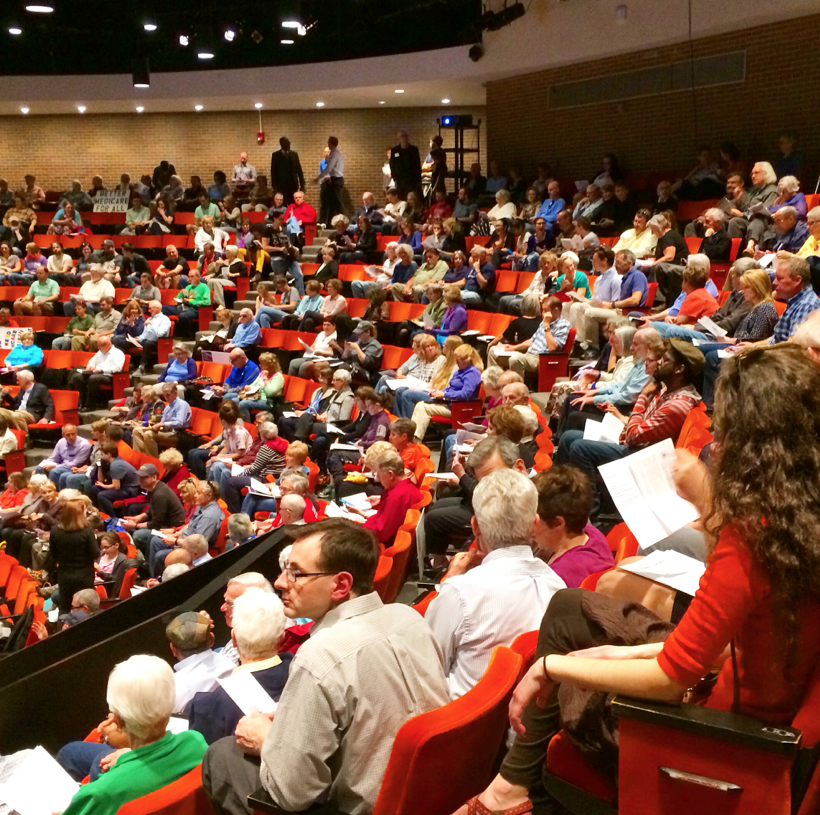
Town hall: caring about our neighbors
Jan Richardson’s April 5 Painted Prayerbook entry prepares us for the Palm Sunday experience. You can see the entire piece plus the beautiful image she created to accompany her post here, along with her Blessing of Palms. Today’s Glimpses of Healing and Hope column employs several paragraphs from her Palm Sunday account as a launching pad for this week’s journey toward Easter, the culmination of the Lenten season.
Richardson suggests that the week leading up to Palm Sunday, celebrated the week before Easter, “invites us to consider how we are moving through our own journey—through Lent as well as through life. Are we allowing ourselves to be swept along by circumstances, traveling our road by default? Or are we seeking to walk with intention and discernment, creating our path with some measure of the courage and clarity by which Christ walked his, even in the midst of forces that may lie beyond our control?”
Swept along and traveling by default or creating a path with courage and clarity? How do we find our way on new turf? Perhaps, as Joyce Rupp notes in her poem Old Maps No Longer Work (in Parker Palmer’s April 6 Facebook post), it is time to “toss away the old map.”
In Rupp's words, “It is time for the pilgrim in me / to travel in the dark, / to learn to read the stars / that shine in my soul. / I will walk deeper / into the dark of my night, / I will wait for the stars, / trust their guidance, / and let their light be enough for me.”
Several times in my life I have been gifted by coming to know people I needed to encounter whose meeting I could not have orchestrated, though I am an experienced planner/organizer. My brother met one of those sorts of people last week as he visited an open house at the elementary school he and I attended through sixth grade.
In all the years since our youngest brother died in 1974 at age 18 in a single-car accident a mile from home, we have not had (or created) occasion to seek out anyone on the scene at the time of his death, but my brother had the presence of mind to ask a volunteer fireman he met at our old school if he remembered hearing about Greg’s death.
“I was there,” replied the fireman, who is also now mayor of our small hometown. Eager journalist that I am, I cannot wait to talk to this man, to mine this opportunity which has fallen across our paths. I have no roadmap for what’s next, but I know there will be a subsequent step on the grief journey for our family, another opportunity to arrive at more closure all these years later.
In addition to navigating our individual lives, many of us find ourselves presently more involved in local activism. A number of Kern Roaders were among approximately 500 persons who attended a moderated town hall on the Affordable Care Act (ACA) Sunday at Century Center in South Bend. The two sponsoring groups, Northern Indiana Community Coalition on Health Care (NICCHC) and Community Wellness Partners, presented speakers who explained provisions of the ACA, as well as citizens who offered moving testimonials of their personal experiences with the ACA. Unfortunately, our invited congresswoman did not attend or respond to invitations to participate.
JoAnn Burke, from the Center for Aging Studies, spoke of the country’s aging population and the lack of a roadmap to sort out appropriate care for all. “Ten thousand baby boomers turn 65 in this country every day; we have to roll up our sleeves and figure out how we are going to take care of all age groups,” she said.
“We don’t know how to do it,” she added as she talked about larger numbers of people living longer, perhaps beyond the time when adequate care can be provided by families as may have been the case when life expectancy was shorter. “Strengthening our nation's health care system is a task for all of us; it's a common decency to care about our neighbors,” said NICCHC representative Debra Javeline in her closing comments. “With no leaders in our districts, we are now the adults in the room.”
Richardson writes that these weeks approaching Easter are prime times to ask, “How do we meet God in motion? How do we move toward the One who is already making his way toward us? Whatever circumstance we may find ourselves in, how do we participate in creating our path? What road is calling to us and has our name written on its stones? Will we go?”
Whether you are presently most engaged by your personal or communal journey, consider the ways you are participating in creating your path. How will you meet the Divine, already coming toward you, as we transition to Easter living at the end of this year's Lenten journey?
In the words of Pastor Janice in her Palm Sunday sermon, “Resurrection power prevails; how are you carrying love rather than violence into the world?”
Add a comment
April 3, 2017
By: Jane Bishop Halteman
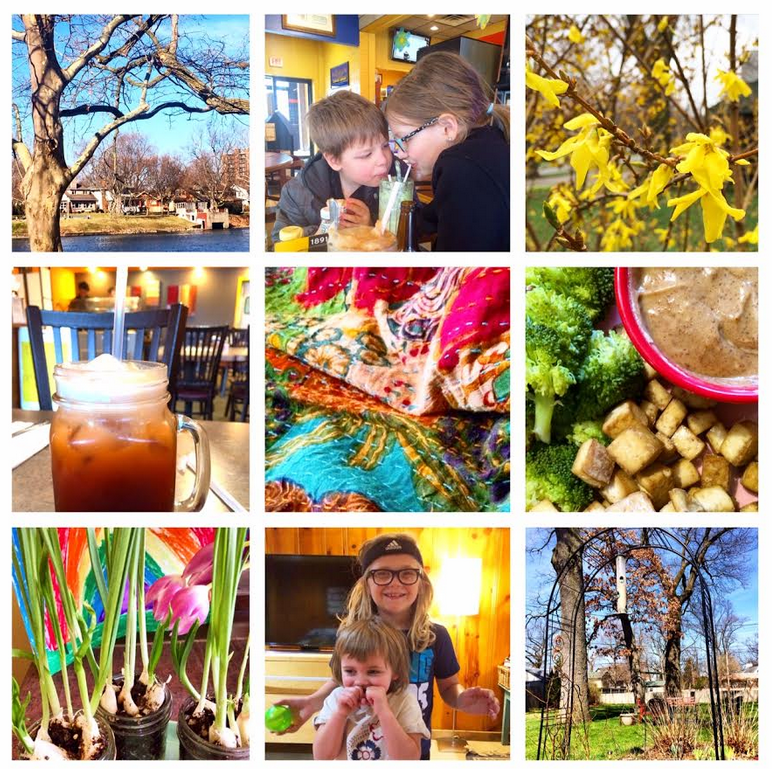
Plugging in, refueling (from recent #100happyday photos)
Parker Palmer hit another home run this past week as he shared May Sarton’s poem “Now I Become Myself” on his Facebook page, along with some of his own questions for reflection.
Three of Palmer’s thought-provoking queries suggest that we consider how our work shapes us, whether or not what we share of ourselves is a renewable resource, and how eventually we might come home to ourselves:
As I do my work, am I aware of how it is shaping me—even as I focus on shaping it and, through it, some part of the world?
Am I giving away that which actually grows in me, so that what I share is a renewable resource? Or am I experiencing the kind of ‘burnout’ that comes from trying to give that which is not mine to give?
When was the last time I stopped running long enough to ‘live all of myself?’ How can I up the odds that I’ll have that experience again—the experience of coming home to myself at long last?
My own days of employment are behind me, but, even without the regularity of work, I sometimes ask myself questions related to Palmer’s: Where do I plug in? Where do I steer clear? Where do I refuel so that I can plug in at the places that seem most authentic to who I am?
These kinds of questions emerge on a regular basis, even for retirees who happily have left behind work-a-day-world jobs to give more time to offering an occasional hand to our children as caregivers for the grandkids. It’s been a busy few weeks, first assisting daughter’s family while son-in-law was out of town and then pitching in for son’s family while daughter-in-law did a conference in Atlanta. This week, which is spring break for the kids in both households but not for their parents, will provide opportunity for the cousins to spend time together.
In addition to full weeks, I’ve managed to distract myself lately on the weekends with church and neighborhood involvement. If you follow this blog regularly, you may have seen mention of attending John and Danile’s hymn sing, prepping and organizing a meal for a KRMC family’s move, watching our own church folks compete at table tennis, singing at a neighborhood choir festival, attending a local mosque open house.
Between visits to area gardens and interfaith prayer services, attending concerts and local plays, celebrating birthdays and sharing meals with friends, I keep myself busy with restaurant outings, small group and area group interactions, committee meetings, reading, writing, and watching political news until I’ve heard once too often about the new administration’s roll-backs that will affect our health, our children's education, the earth, and marginalize even further the already marginalized.
How do I handle questions about plugging in, steering clear, and refueling when I am distraught about the news? I appreciated Barbara’s quieting exercise Sunday morning at the start of her sermon as she invited us to breathe in the breath of the Creator and breathe out anxiety and fear, anger and frustration. Our visio divina adult formation class offered opportunity to draw strength from each other and a friend’s photography as we waited in the silence for a personal invitation shaped by the photograph and the circumstances of our lives. We imaged new life, possibility, anticipation while sitting with a vibrant photograph of a dead iris.
Small group later that day offered good food and fellowship, as we caught up on the details of each others' lives. Connections with family members rounded out the day’s fueling…talking to my 92-year-old mom and, after that, a long text conversation with my brothers about childhood memories sparked by an elementary class picture I ran across in my iPhoto library. Yes, it is good to find ways “to live all of ourselves.”
How are you coming home to yourself during this Lenten season? How are you plugging in, steering clear, refueling so that, ultimately, you will be available to the other?
Add a commentMarch 27, 2017
By: Jane Bishop Halteman
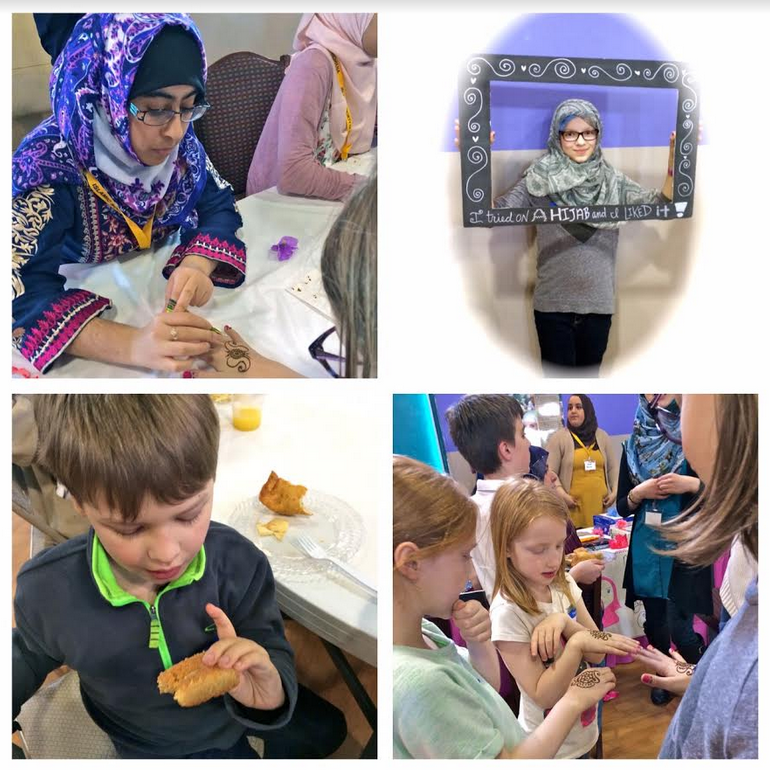
KRMC kids visit henna and hijab booths and sample amazing Mediterranean food!
We arrived with grandchildren in tow at the Islamic Society of Michiana’s (ISM) mosque open house Saturday about 15 minutes after the announced starting time. The large parking lot already was packed and lines snaked out the door as visitors were greeted warmly both inside and outside the facility.
Lingering a while in the outdoor kids’ play area where we met another KRMC family, we eventually made our way to the front entrance of the community center, located next door to the mosque. After signing in and receiving nametags, we visited the kids’ corner, where a listening center and coloring crafts were offered. A volunteer stationed there told us that the huge crowd, some of whom began to gather an hour before the announced starting time, was a wonderful surprise.
We had signed up in advance via an Eventbrite.com registration option attached to the mosque's invitation, but it seemed some attendees had not. Wondering how many participated in the 2-5 p.m. event, I inquired at the ISM Facebook page about numbers after our return home Saturday. I learned Sunday by early evening that, while officials continue to calculate attendance, best estimates put participants at close to 1,000!
We also visited the henna and hijab booths and enjoyed sampling a lovely array of Mediterranean cuisine including potato samosas, spinach pie, hummus and pita, falafel, baklava…delightful dishes we were first introduced to back in the 80s by the family of a Palestinian friend and more recently have enjoyed in regular treks to local eateries like Aladdin’s and Elia’s. All of this, and more including Q and A opportunities with Imam Sirajuddin and others, a men’s booth, observation of prayers, and tours, were offered with a generous, hospitable spirit at no charge.
According to the invitation which appealed to “neighbors of all backgrounds” to attend, “Mosque open houses and solidarity events across the country have drawn hundreds of people in recent weeks. There is a growing interest in getting answers and clearing misconceptions. This open house will help our neighbors and people of curiosity to educate, dispel myths, and remove fear of the unknown. It will provide an opportunity for the general community to get acquainted with their Muslim neighbors, learn about Islam and its various cultures.”
The ISM, located at 3310 Hepler St., identifies itself as a non-profit religious organization, striving “to provide Michiana Muslims with spiritual, educational, and social activities. Our goal is to help area Muslims to maintain their Muslim identity, to live up to the ideals of Islam, to love God, and serve their community and country.”
Participants were offered an evaluation form, a hallmark of most well-planned events, seeking feedback on the suitability of the open house time, snacks, presentations, and overall experience. Another question asked if attendees might return for a future mosque open house. KRMCers, if you missed the opportunity this past weekend, make sure you attend a future open house should one be scheduled!
One excited ISM Facebook follower reported after her visit to the “know your neighbor” open house: “Got a henna tattoo, tried on a scarf, received calligraphy of my name translated into Arabic, had a tour, and talked to some really great people. When is the next open house?!” Another said, “An amazingly happy time of fellowship with our neighbors!” One of my Facebook friends responded positively to the “laughter, food, conversation, hospitality, and respect. This is the country, the America, that I want to live in.”
And an enthused Instagram user shared this about her family’s visit: “Learning about what makes our neighbors special and unique…love that they opened themselves up to us and answered our sometimes ignorant questions with kindness and warm hospitality. #solidarity #equality #dispellingassumptions #loveothers”
Totally on target, enthused Instragram user! What a fantastic way for our Muslim neighbors to reach out to welcome us during a time when our country's political climate has been less than welcoming to them.
For more local coverage of the story, check out these links from the South Bend Tribune, WSBT, and ABC57.
What else might we be doing to become acquainted with our neighbors during our season of Lent? “Exchange hospitality,” says Michael Howes in a Mennonite USA article back in 2015. “Both Mennonites and Muslims are big on interwoven families. We both put energy into maintaining a countercultural faith position, and transmitting that to the next generation. And we both love to eat, filling plates with a rainbow of foods.” Finding common ground is a great place to begin.
As yard signs like the one below continue to proliferate across our South Bend community, we are pleased to give credit for their origin to our Mennonite brothers and sisters in Virginia! This Glimpses of Healing and Hope entry offers more information on how these signs, which are available locally at Just Goods, came into being.
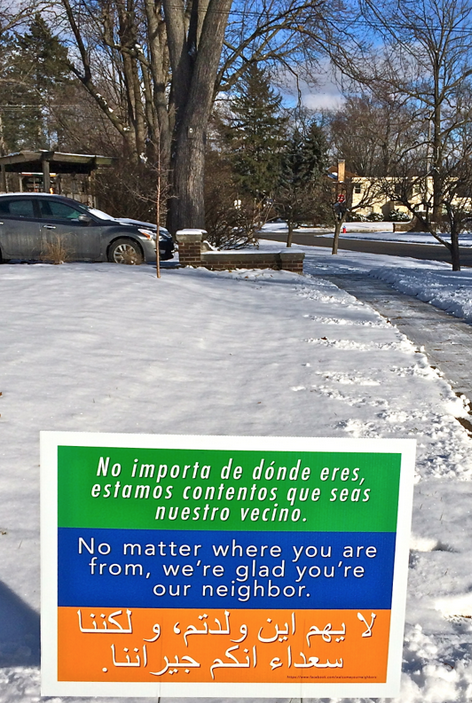
March 20, 2017
By: Jane Bishop Halteman
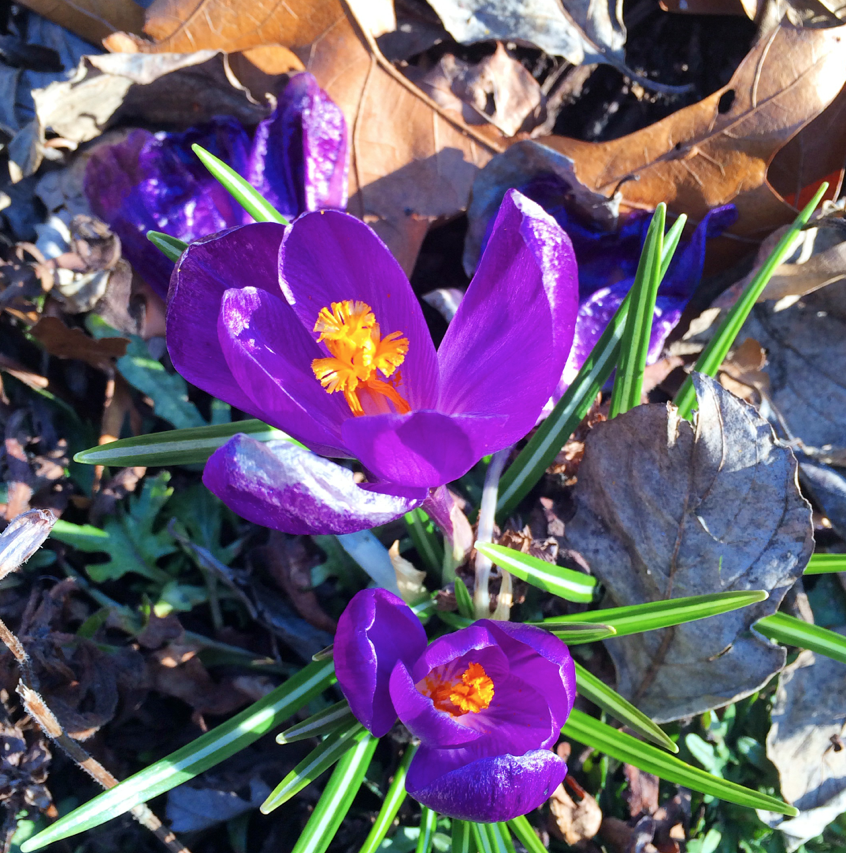
We look to spring to make all things new; in our part of the world, we anticipate the muddy soil drying out and eventually turning green, cloudy skies becoming blue again, birds who flew south for the winter returning. Even our wintery spirits seem to lift as the sun shines longer and brighter, and evidence mounts that the earth is beginning another new cycle of growth.
Macrina Wiederkehr, in her book The Circle of Life co-authored with Joyce Rupp, suggests that spring is a good time to “meditate on the return of life. How are we, like the buds of the earth, opening to God and to others? What secrets buried deep in the soil of our soul are being revealed to us? How is the gospel of springtime unfolding for us? What is the great blossoming in us?”
Like my embattled crocuses, who finally decided yesterday that it was safe to bloom after emerging from the ground two weeks ago, our wintered-over souls take new courage as days lengthen and signs of new life appear from amidst the left-over debris of last year’s dried-out stalks and withered flowers. The surviving crocuses, somewhat the worse for wear having weathered more winter since they poked through the ground, are blooming brightly but not without tatters and tears. They remind us that new life, new flowerings will follow pain, despair, failure, trauma.
Many spring blossoms unfurled this past weekend for KRMCers who live in the western area group. Not only did we welcome Vic and Nancy, who started their move Saturday from Buchanan, MI, to South Bend’s Near Northwest Neighborhood (NNN), but some of us represented Kern Road Saturday night in a neighborhood choir festival hosted by the NNN, and others of us and the wider KRMC family watched four of our area group members compete Saturday/Sunday in the St. Joe Valley table tennis open.
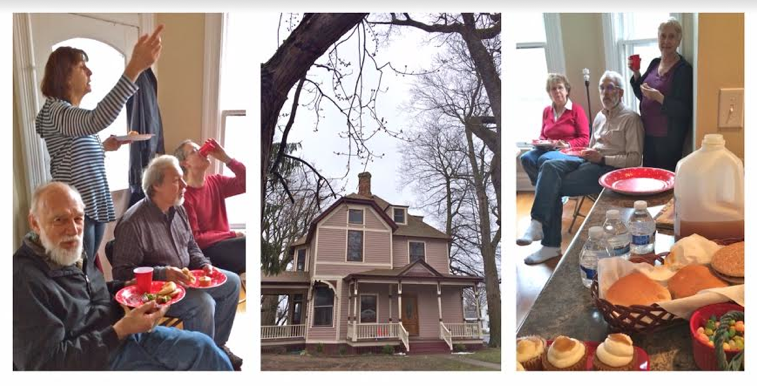
The community pitches in to help Vic and Nancy move to the Near Northwest Neighborhood
Members of their former area group and small group and other KRMCers helped move boxes out of Vic and Nancy’s Buchanan house, and several of us from their new area group welcomed the movers and home owners with lunch and offered more pairs of hands to cart boxes inside. I love Nancy’s desire to foster a drop-in culture at their South Bend home. Her February 8 blog post at The Practical Mystic says this: “The room that really captured my imagination on this fourth look at the Pink Lady was the dining room. It is big. Before, I just thought, that is a really big dining room. Yesterday I began picturing our table in it with all the extra boards. People dining around it or learning English around it or writing letters to Congress around it. The dining room is big enough to be a neighborhood hub in itself.” That blossoming hub is another sign of spring!
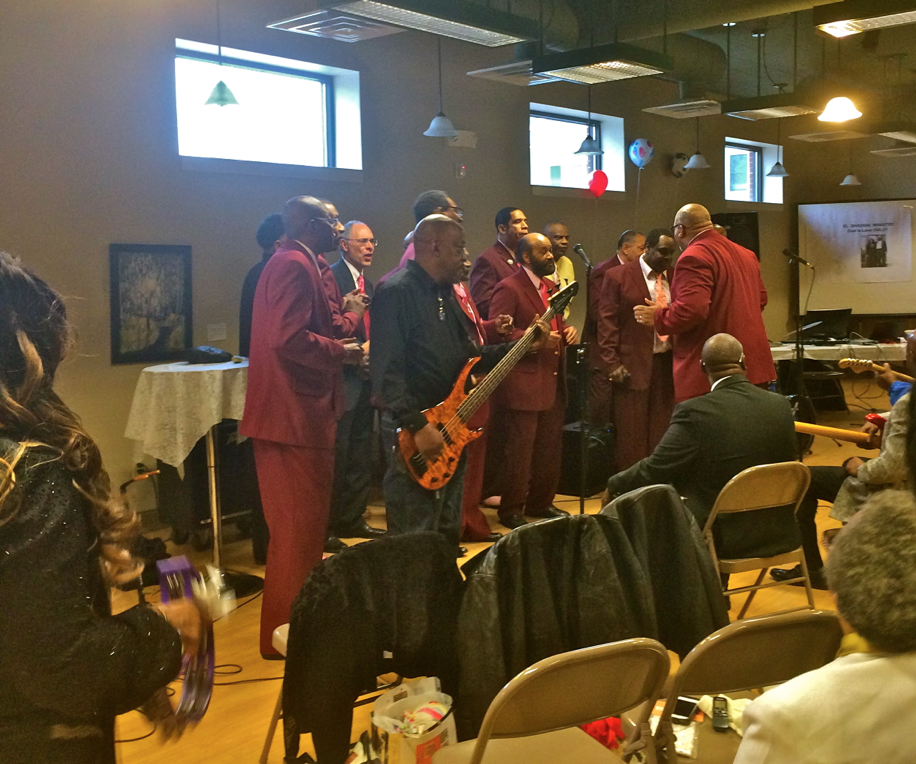
Andre sings with neighborhood choir
Andre and Brenda recruited about 15 KRMCers to sing Saturday night at the neighborhood choir festival, sponsored by a Black men's choir in which Andre participates. Many thanks to him for responding to the invitation to include our pick-up choir in this cross-cultural opportunity, where we connected with other people of faith in the neighborhood...yet another springtime blossoming for our KRMC family.
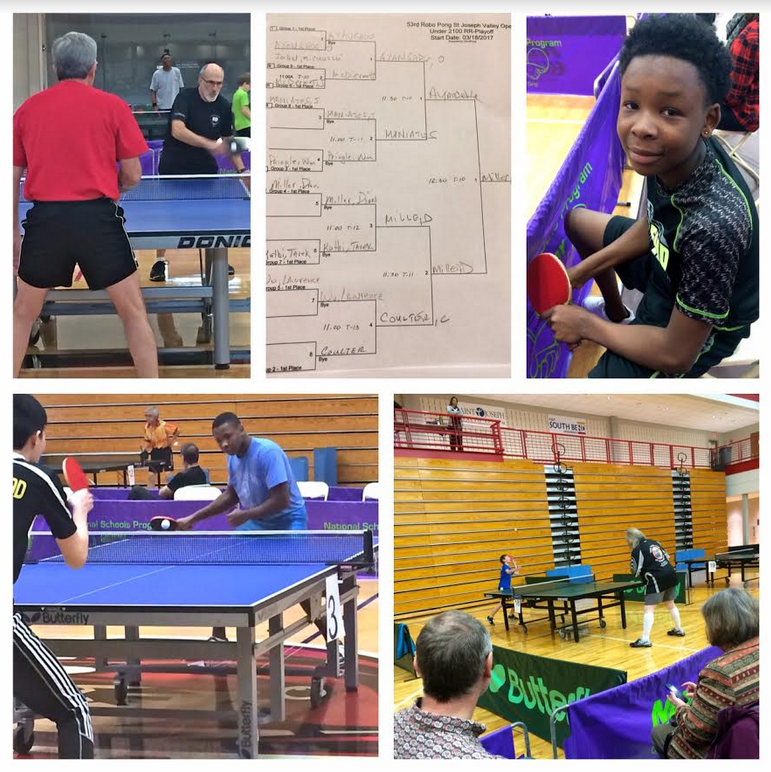
Phil, Dion's win (under 2100 RR-playoff), Dionta takes a break, Dion, Marty (with Andre and Barbara)
During our sharing time at the conclusion of our Lent 3 worship service Sunday, a KRMCer offered that, for him, “hearing stories at the table tennis open revealed another dimension of our church at work.” Spectators shared the excitement of players Phil, Dion, Dionta, and Marty, rejoicing with them in their victories and feeling the pain of tough losses. Learning more about each other as individuals represents spring blossoming.
In what way might you turn deepening connections inside and/or outside the community into a worthwhile Lenten practice? Today is the first day of another spring; how will you allow spring into your life this Lenten season? Consider these spiritual exercises from Spirituality & Practice for your celebrations of the start of spring this week.
Add a comment
